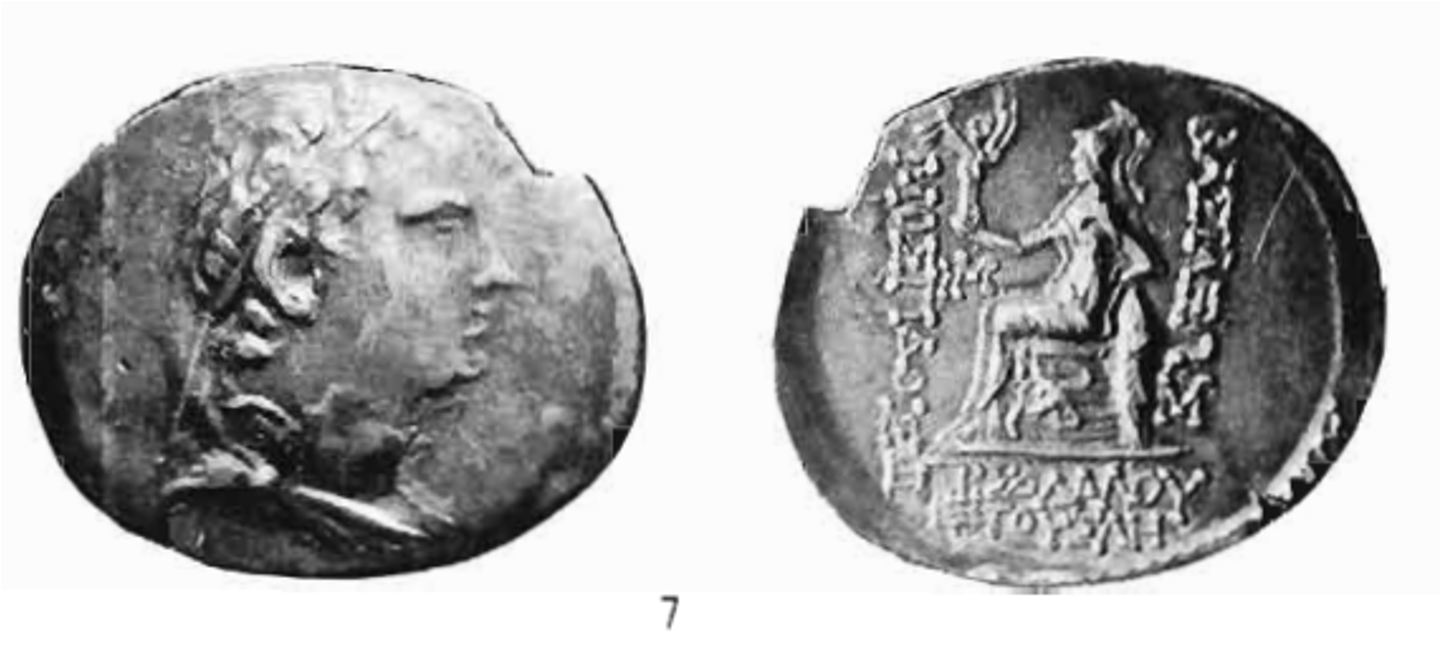Latest revision as of 14:03, 17 November 2023
130 BCE - 110 BCE | ΒΑΣΙΛΕΩΣ ΜΟΣΤΙΔΟΣ ΕΠΙΣΑΔΑΛΟΥ ΕΤΟΥΣΛΗ
Overstriking coin
SO 388 - Uncertain mint in Thrace over Thasos.png
Overstruck variety
Thasos tetradrachm.jpg
Description
| ObverseInscription or printing placed on the obverse.:
|
Bust of the King, right, diademed and wearing chlamys
|
ReverseInscription or printing placed on the reverse.:
|
ΒΑΣΙΛΕΩΣ ΜΟΣΤΙΔΟΣ ΕΠΙΣΑΔΑΛΟΥ ΕΤΟΥΣΛΗ (Greek) Athena, wearing helmet chiton and peplos, seated left on throne, against which she leans shield, she holds in right hand, Nike crowning King's name, her left rests on seat.
|
Mint and issuing power
| MintIdentifies the place of manufacture or issue of a numismatic object.:
|
Uncertain mint
|
Ancient regionAncient region.
|
Thrace
|
Modern countryModern country: unknown
|
AuthorityIdentifies the issuing power. The authority can be "pretended" when the name or the portrait of X is on the coin but he/she was not the issuing power. It can also be "uncertain" when there is no mention of X on the coin but he/she was the issuing power according to the historical sources:
|
Mostis (king of the Caeni, 130-90 BC)
|
Chronology
| FromIdentifies the initial date in a range assigned in a numismatic context. 130 BCE toIdentifies the final date in a range assigned in a numismatic context.. 110 BCE
|
Hellenistic 323-30 BC  periodTime period of the numismatic object. periodTime period of the numismatic object.
|
Physical description
MetalThe physical material (usually metal) from which an object is made.: Silver 
|
WeightWeight of the numismatic object (in grams). in grams: 16.2316.23 g <br />16,230 mg <br />
|
DenominationTerm indicating the value of a numismatic object. Examples: tetradrachm, chalkous, denarius.: tetradrachm 
|
AxisDescribes the directional relationship between the obverse and reverse of a numismatic object.: 1212 mm <br />1.2 cm <br />
|
| DiameterDescribes diameter of an object (in mm).: 3838 mm <br />3.8 cm <br />
|
StandardStandard.: Attic
|
References
Description
| ObverseInscription or printing placed on the obverse.:
|
Head of young Dionysos right, wearing ivy wreath
|
ReverseInscription or printing placed on the reverse.:
|
ΗΡΑΚΛΕΟΥΣ ΣΩΤΗΡΟΣ ΘΑΣΙΩΝ (Greek) erakles standing facing, head left, holding club in right hand, lion skin draped over left arm
|
Mint and issuing power
| MintIdentifies the place of manufacture or issue of a numismatic object. ᵖ:
|
Thasos
|
Ancient regionAncient region. ᵖ
|
Thrace
|
Modern countryModern country: Greece
|
AuthorityIdentifies the authority in whose name (explicitly or implicitly) a numismatic object was issued. ᵖ:
|
|
Chronology
| FromIdentifies the initial date in a range assigned in a numismatic context. 168 BCE toIdentifies the final date in a range assigned in a numismatic context.. 60 BCE
|
Hellenistic 323-30 BC  periodTime period of the numismatic object. periodTime period of the numismatic object.
|
Physical description
| DenominationTerm indicating the value of a numismatic object. Examples: tetradrachm, chalkous, denarius. ᵖ:
|
tetradrachm 
|
StandardStandard. ᵖ:
|
Attic
|
References
References
- ^ Callataÿ, François de (1991), “Le roi thrace Mostis et une surfrappe d'un alexandre tardif de Mésembria”, Revue belge de Numismatique, 137, p. 37-45, pl. 2
- ^ Hoover, Oliver D. (2017), Handbook of Coins of Macedon and Its Neighbors. 3. Part 2: Thrace, Skythia, and Taurike, Sixth to First Centuries BC, Lancaster-London, xix, 232 p.
- ^ Sear, David R. (1978), Greek coins and their values. Vol. I, Europe, London, xl, 316 p.
- ^ Hoover, Oliver D. (2010), The Handbook of Greek Coinage Series, volume 6 : handbook of coins of the islands: Adriatic, Iionian, Thracian, Aegean, and Carpathian seas (excluding Crete and Cyprus), sixth to first centuries BC, Lancaster, 358 p.

